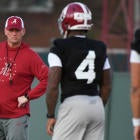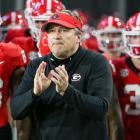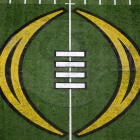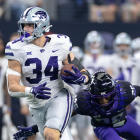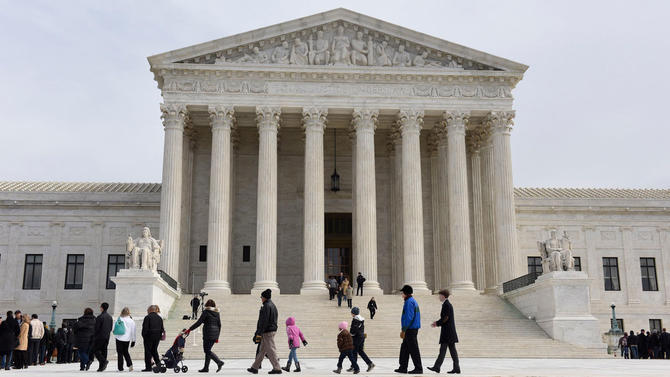
For years, the NCAA said it was willing to take the Ed O'Bannon case to the U.S. Supreme Court. On Friday, the NCAA officially joined the O'Bannon plaintiffs by making a risky petition for the highest court to hear the case regarding whether college athletes should be allowed to get paid for use of their names, images and likenesses (NILs).
"For different reasons, both the NCAA and Ed O'Bannon believe the 9th U.S. Circuit Court of Appeals used the wrong tests to analyze the NCAA rules," NCAA chief legal officer Donald Remy said in a statement Friday. "The NCAA asked the Supreme Court to hear the case to obtain unquestionable clarity on key issues of law affecting the NCAA and other similar organizations. In short, we are asking the Supreme Court to reaffirm its antitrust holding in the Board of Regents case, endorse the 9th Circuit's affirmation of amateurism, and define the appropriate scope of the First Amendment. We believe the Supreme Court can conduct this review properly and dictate the appropriate tests by accepting the questions we have presented and rejecting those presented by O'Bannon."
The odds are long the case will be heard by the Supreme Court, which is currently short one justice after the death of Antonin Scalia. Still, a Supreme Court petition by the NCAA is a significant moment in its own right and filled with risks and rewards for the association if the request is granted.
Here's a primer on how the O'Bannon case got here and what might happen next:
What's at stake?
At issue is whether college athletes should be allowed to get paid for use of their names, images and likenesses. The case was first filed in 2009 on behalf of O'Bannon, a former UCLA basketball star in the 1990s. The heart of the case was video games, but the allowance of money to players could be for any type of licensing revenue.
U.S. District Judge Claudia Wilken decided in August 2014 that the NCAA's rules for its amateurism-related goals were too restrictive and violated antitrust law. Wilken's remedy: Schools could pay football and men's basketball layers cost of attendance stipends, and they could pay up to $5,000 per year for use of their NILs that would go into a trust fund to collect after leaving college.
Last September, the Ninth Circuit Court of Appeals affirmed Wilken's finding of price fixing and her cost attendance remedy, but it reversed her decision on $5,000 payments. In a 2-1 vote, the Ninth Circuit said the "district court ignored that not paying student-athletes is precisely what makes them amateurs." The Ninth Circuit said that "the difference between offering student-athletes education-related compensation and offering them cash sums untethered to educational expenses is not minor; it is a quantum leap."
Why would the NCAA and O'Bannon appeal?
While the Ninth Circuit eliminated the $5,000 payments, it set a legal precedent the NCAA doesn't like. The Ninth Circuit took away the NCAA's longstanding defense that amateurism is protected by the 1984 Supreme Court ruling in Oklahoma v. Board of Regents, which included language that said in part "athletes must not be paid." The Ninth Circuit in O'Bannon determined that NCAA amateurism rules "must be proved, not presumed," and "even if the language in Board of Regents addressing amateurism were not dicta, it would not support the tremendous weight that the NCAA seeks to place upon it."
That means the door is open for antitrust theories to attack all of the NCAA rules used to regulate college sports. When it comes to paying players, the Ninth Circuit left a window open -- however small as it may be -- for cases with different factual records to try to prove a different outcome than O'Bannon. The NCAA is fighting two other antitrust cases related to its compensation rules that have been granted class-action status for injunctive relief to allow more money to players.
"The NCAA should not have to undergo a full trial (and years of litigation) or face treble damages whenever a plaintiff or counsel hits on a supposedly better way to administer college athletics," the NCAA wrote in Friday's filing.
An NCAA win at the Supreme Court could strengthen or clarify once and for all how antitrust laws impact the NCAA. Still, the petition carries a tremendous risk for the NCAA, which sought and received two deadline extensions before filing its Supreme Court petition. The higher court could decide that athletes should be paid, perhaps even by an unlimited amount compared to Wilken's $5,000 cap.
For O'Bannon, losing at the Supreme Court could be a major financial blow for his lawyers. If the Supreme Court overturned the antitrust violation finding, O'Bannon's lawyers could lose all or some of the $42.3 million in legal fees recently awarded to them by Wilken. O'Bannon attorney Michael Hausfeld has said there's a "fundamental underlying principle" about applying antitrust law to the NCAA that will never reach closure without a Supreme Court decision.
What is the NCAA's appeal based on?
The NCAA raises two questions. One, did the Ninth Circuit err in determining that NCAA rules defining player eligibility violates antitrust law? Two, does the First Amendment protect a speaker against a state-law right-of-publicity claim based on the realistic portrayal of a person in an expressive work -- in this case, a college athlete in an NCAA video game?
In its filing Friday, the NCAA said the Ninth Circuit's "micromanagement" was improper by determining which expenses must be reimbursed to athletes and shouldn't have labeled the NCAA an antitrust violator "just because it did not allow reimbursement of every last one of those expenses." The NCAA said the ruling "jeopardizes the vitality of not only the NCAA and other amateur sports leagues but also joint ventures more generally."
The NCAA passed the allowance of cost of attendance stipends in 2014, permitting schools to reimburse athletes for supplies, transportation and other miscellaneous expenses. The NCAA said it was "untenable" for the Ninth Circuit to determine the association violated antitrust law by allowing athletes to be reimbursed for one set of expenses (those included in the pre-2014 scholarship limit before cost of attendance passed) rather than a slightly bigger but overlapping set (cost of attendance stipends).
"Which expenses can be reimbursed consistent with amateur status is a matter of judgment, not something amenable to a single 'right' answer," the NCAA wrote.
It later continued, "The Ninth Circuit gave no explanation for treating COA as the single, unquestionably 'correct' set of expenses against which the challenged rules should be measured. Nor did it address what it would mean for the NCAA if Congress re-defined COA in the future. The decision below could be read to mean that the NCAA would have to implement such a change immediately -- no matter what it was -- on pain of again being labeled an antitrust violator. There is no principled basis for that conclusion."
The NCAA also went after a First Amendment argument that was part of the O'Bannon case several years ago but disappeared at trial. The NCAA claimed the Ninth Circuit's ruling relied on an incorrect interpretation of the First Amendment, drawing a conclusion that athletes whose names, images and likenesses were used in NCAA video games could benefit from a state-law right-of-publicity claim.
"That interpretation of the First Amendment implicates a severe splintering of lower courts regarding important free-speech principles," the NCAA wrote.
What is O'Bannon's appeal?
The O'Bannon lawyers filed their Supreme Court petition in March. They argued the Ninth Circuit's reasoning for overturning the $5,000 payments was backwards through an impermissible use of what's called the Rule of Reason analysis in antitrust law. O'Bannon argued that the burden should have been on the NCAA to show why Wilken's remedy was inappropriate, "which the NCAA never did."
Wrote O'Bannon lawyers: "This Court has made clear that the antitrust statutes vest the district courts with broad remedial power, with no requirement that the courts make the kinds of findings on which the Ninth Circuit insisted (e.g., that a remedy is 'virtually as effective' as the restraint in serving its alleged purposes, 'without significantly increased cost')."
Also, O'Bannon argued that the Ninth Circuit conflicted with court precedent by embracing amateurism as a procompetitive justification to not pay players. Consumer demand if players are paid, not amateurism, should be the concern of antitrust law, O'Bannon's lawyers said. "So defined, 'amateurism' is not an 'effect' of the restraint at all, much less a procompetitive effect," O'Bannon lawyers wrote. "It is simply another way of describing the restraint itself."
What are the chances the Supreme Court hears O'Bannon?
The Supreme Court takes only about 1 percent of petitioned cases and does so only for compelling reasons. Among the reasons it cites: conflicting lower-court decisions on the same important matter; a state court or federal court of appeals deciding an important question of federal law that should be settled by the Supreme Court; or an important lower-court federal decision that conflicts with past Supreme Court decisions.
Because there are eight justices at the moment, only four votes are needed for the court to accept O'Bannon. But the Supreme Court has struggled lately to proceed with eight members since Scalia died on Feb. 13. They have granted fewer cases than usual to hear next term.
On rulings from cases previously accepted before Scalia died, the justices have deadlocked 4-4 on three occasions. When the court is evenly split on a case, it affirms the decision of the appeals court that heard the case and does not set any Supreme Court precedent. President Barack Obama nominated Judge Merrick Garland to fill Scalia's seat, but Republican senators so far are blocking a hearing and vote on his nomination.
Both O'Bannon and the NCAA are allowed to file reply briefs to the court. The NCAA also filed an opposition to the O'Bannon petition. There is no deadline for when the Supreme Court must decide whether to hear the O'Bannon case. The court will eventually enter an order either accepting or denying the petitions.
Who's arguing the appeal for both sides?
The NCAA and O'Bannon turned to heavy-hitting lawyers with Supreme Court experience for this portion of the case.
Since 2013, the NCAA has been using attorney Seth Waxman from the law firm WilmerHale. Waxman served as U.S. solicitor general from 1997 to 2001 and has delivered 75 oral arguments to the Supreme Court. The NCAA has not publicly revealed how much it has spent on legal fees in the O'Bannon case since it was filed in 2009.
The O'Bannon team is now using attorney Jonathan Massey from the law firm Massey & Gail. Massey, a former law clerk to ex-Supreme Court Justice William Brennan, has argued three Supreme Court cases and filed briefs to the court in more than 75 cases. Massey represented Al Gore in Bush v. Gore during the recount of the 2000 presidential election.
How often has the NCAA gone to the Supreme Court?
The Supreme Court has heard three NCAA cases: NCAA v. Oklahoma Board of Regents in 1984 (the NCAA lost control of television money to schools); NCAA v. Jerry Tarkanian in 1988 (the NCAA won the right not to follow the same constitutional guidelines when investigating violations); and NCAA v. R.M. Smith in 1999 (the NCAA won the ability not to be sued under Title IX since it's not federally funded). We'll eventually know if the NCAA goes before the highest court for a fourth time.













